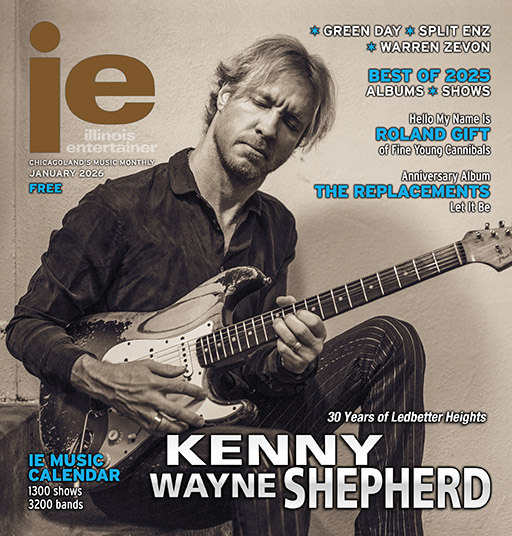Allá interview
Allá
(Pet) Sonidos De Los Animales Favoritos (Sounds)

“My goal,” says Jorge Ledezma, “is that we get a Latin Grammy nomination.”
The “we” to whom Ledezma refers is Allá (pronounced “ah-yah”), a Chicago-based band that, in addition to Ledezma, includes drummer Angel Ledezma (Jorge’s older brother) and singer Lupe Martinez. The album for which he wants Grammy recognition is Es Tiempo, Allá’s imm-aculately produced and just-released debut. Given Es Tiempo took Jorge two years to record, a year to mix, another to master, and one more to release (on the Brussels-based Crammed Discs label), its title — It’s Time in English — will strike those alert to irony as almost comic understatement.
From the first notes of the opening track, “Un Día Otra Noche,” however, it’s obvious Ledezma’s pain-stakingly deliberate strategy was the right one. No sooner have the bossa nova rhythms of his undergirding acoustic guitar and Angel’s percussion begun when strings and Martinez’s multiply overdubbed vocals swoop in, and suddenly the listener is transported from the sonic straitjacket of 21st-century pop to the forever now of classic psychedelia.
And unlike the creators of some of his favorite albums, Ledezma oversaw Es Tiempo‘s execution entirely without the aid of hallucinogenic substances. It’s an abstention made especially impressive in light of the fact he describes as a “big inspiration” the album that inaugurated Brian Wilson’s drug phase. “I would tease people in the studio: ‘Oh, I’m making the Chicano Pet Sounds,'” Ledezma says. “But I really did want to make that sort of landmark record for Latino music.
“Besides,” he adds, further explaining his on-the-job sobriety, “I knew that I had to be coherent in the studio.”
Ledezma also had to be coherent simply to remeber the studios’ locations. Not only did he use three located in the U.S. (Engine Studios and Soma Electronic Music Studios in Chicago; Key Club Recording in Benton Harbor, Michigan), but he also traveled to Sweden’s Tambourine Studios Malmo to oversee the recording of the strings and considered London’s legendary Abbey Road. “But, as they charged more than $1,000 a day,” he explains, “it was probably out of my league.”
Ledezma says “probably” because, where the making of Es Tiempo was concerned, money was no object. Originally intended as an album by Defender, an experimental band in which he and Angel performed until its demise, it became the genesis of Allá when Jorge “picked up the tab” and “kind of took over.” Eventually, he found himself “$40,000 or $50,000 in,” even moving back home with his parents to make ends meet. “I thought, ‘This is my one chance to make a record, and I’m going to put everything I’ve got into it.'”
While only two of its dozen songs actually segue directly into one another — the spooky instrumental “Sazanami” (which features Japanese guitarist Keiichi Miyashita) and “La Montaña Sagrada” — Es Tiempo comes across less as a collection of songs than as one long, dreamily visionary suite. By the time the last notes of the closing track, “Golpes Del Sol,” begin fading, listeners taken in by the album’s flow will find it hard to believe they’ve been listening for nearly 41 minutes.
Another benefit of self-financing the album is Ledezma was able to minimize the extent to which a bill-footing record company might insist on tampering with “their” product. “I was a big fan of Crammed,” says Ledezma, “especially their records by Bebel Gilberto [Momento] and Konono No. 1 [Congotronics]. They had a very global approach to music, and I definitely appreciated that.” By the time he mailed Crammed the album, everything — from the mastering to the artwork — was done. “I just attached a Post-it note that said, ‘We love your music, and I hope you like ours,’ crossed my fingers, and didn’t think about it. Three weeks later they e-mailed me, saying, ‘We want to put this out.’ It was kind of a surreal experience.”
Not unlike Es Tiempo itself. Ledezma traces the music’s reverie-inducing textures to several factors, one of the most significant, perhaps, being his desire, as a self-described “big music nerd” and “fan of how records were made,” to emulate another of his studio heroes, Phil Spector. “We didn’t literally do the Wall Of Sound,” he says, “but I did push the reverb quite a bit.”
He also hired one of the finest engineers he could afford in Colin Studybaker, whose impressive résumé includes albums by Robbe-Grillet, The National Trust, and Iron And Wine. “He’d worked with [producer] Brian Deck [Counting Crows, Modest Mouse] and picked up tricks from him,” says Ledezma. “So when I’d go into the studio, he would say, ‘Hey, we did this at a session with Iron And Wine — we should try it.’ He’d also worked with R. Kelly’s engineer on The National Trust, so when I was trying to get an R&B sound out of the vocals, he’d say, ‘Hey, I know what to do!'”
The strings, of course, also account for a good deal of Es Tiempo‘s psychedelic feel. “I love the string sound on the records of this Swedish pop band called Eggstone. So I did some research and found out that they run their own studio and that you can commission them to do string arrangements. I sent them the songs I wanted strings on, and they wrote back saying, ‘Yeah, we can work with this.'”
Then there are the all-Spanish lyrics. While the titles are simple enough to be parsed by anyone who ever passed Spanish I, the lyrics — due in part to Ledezma’s heavy reverb finger, Lupe Martinez’s phrasing, and Ledezma’s decision not to reprint them inside the CD cover — may be only semi-intelligible on a literal level even to fluent speakers. In other words, despite its release in a politically charged election year in which Mexican-American issues play a not inconsiderable role, there’s little chance Es Tiempo will be misconstrued as a call to arms. (For that matter, “Allá” is the Spanish term for “faraway place” and not the Spanish term for the God of Islam.)
By far, however, the dreamiest ingredient of Es Tiempo is Martinez, a Chicago-based singer-songwriter who was “discovered” by a friend of the band’s while singing pop songs at an open-mic night. When Ledezma himself laid eyes (and ears) on her, he knew he’d found his ideal frontperson.
“I definitely felt that we had to have a Mexican-American lead singer, and a woman. It was very important for my vision of Allá. Plus, she had to be able to sing, play an instrument, and write her own songs.”
And that wasn’t all. “She also had to have a charismatic stage presence,” adds Ledezma. “It took me a couple of years to find her.”
But once Ledezma had, the Allá puzzle was finally complete. “We went to Key Club studios,” he recalls, “and she knocked out six songs in one session” — in other words, half the album. “Everybody at the studio was blown away.”
And now, with Crammed Discs making Es Tiempo available to the world, everybody outside the studio can be blown away too.
— Arsenio Orteza











